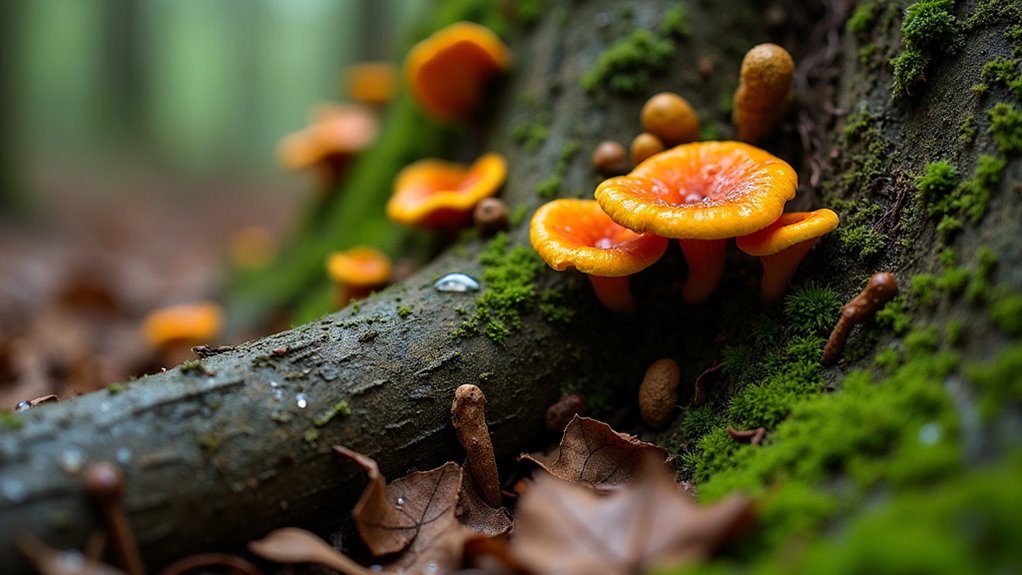Animals mark their turf mainly through scent, leaving chemical signals like urine, feces, or gland secretions along boundaries and specific locations. These marks communicate ownership, signal reproductive status, and help deter intruders without direct confrontation. They often choose prominent spots near water or trail intersections to make sure their message is clear. If you want to understand how these subtle signs help animals defend their space and maintain social order, keep exploring.
Key Takeaways
- Animals mark territory boundaries with urine, feces, or gland secretions to communicate ownership and deter intruders.
- Scent marks contain information about identity, reproductive status, and health, serving as persistent territorial signals.
- Strategic marking locations like water sources and prominent trees clearly define territorial limits.
- Different species produce distinctive scent profiles that stand out from background odors to effectively signal presence.
- Scent marking helps animals navigate, establish social hierarchies, and reduce conflicts over resources.

Many animals mark their territory to communicate with others and establish boundaries. When you observe animals in the wild or even in your backyard, you’ll notice that they use scent marking behaviors as a primary way to claim their space. These scent cues serve as signals to other animals, informing them where their territory begins and ends. By doing so, animals reduce conflicts and avoid unnecessary confrontations over resources like food, mates, or shelter. Understanding how animals mark their turf helps you appreciate the complexity of their communication and the importance of territorial boundaries in their survival.
Scent marking behaviors involve depositing chemical signals through various methods, such as urine, feces, gland secretions, or scratch marks on trees and ground surfaces. For example, many canines, like wolves and foxes, frequently urinate on specific spots along their territory boundaries. These scent marks contain information about the individual’s identity, reproductive status, and even health. When other animals detect these signals, they interpret them to decide whether to avoid or challenge the mark. This form of communication is highly effective because chemical signals can last for days or even weeks, providing a persistent reminder of territorial claims.
You might notice that animals often mark their territory at strategic locations, such as near watering holes, prominent trees, or along pathways they regularly patrol. These points act like boundary posts, clearly delineating the extent of their domain. Some animals, like cats and certain rodents, use scent glands located around their face, paws, or tail to leave behind subtle signals as they move through their territory. Others, like mustelids or big cats, rely heavily on urine marking to establish their presence. The act of scent marking is not random; it’s a deliberate behavior aimed at communicating who owns the space and deterring intruders.
The effectiveness of scent marking behaviors hinges on the animal’s ability to produce distinctive chemical signals that stand out from background odors. Different species have evolved unique scent components tailored to their environment and social structures. As an outsider, you can often tell when an animal has marked its territory by the strength and freshness of the scent. When you come across these marks, you’re essentially seeing a message board left by the animal, saying, “This is my space; stay away.” Recognizing these signs helps you understand the importance of territory boundaries and how animals use scent to navigate their social landscape.
Frequently Asked Questions
How Do Animals Choose Their Marking Sites?
You might wonder how animals pick their marking sites. They usually choose spots near territory boundaries, where scent marking behavior can effectively communicate their presence. These sites are strategic, often high or prominent, to guarantee their scent is noticed by others. By selecting these locations, animals establish clear boundaries, reducing conflicts and reinforcing their dominance, making scent marking a essential part of their territory management.
What Chemicals Are Involved in Animal Scent Marking?
Think of chemical signaling as nature’s secret language, much like a covert message in a spy novel. When animals engage in marking behaviors, they release chemicals such as pheromones, urine, and glandular secretions. These substances serve as signals to others, marking territory, attracting mates, or communicating dominance. The specific chemicals involved vary among species but generally include amino acids, steroids, and volatile compounds that convey essential social information.
Do Animals Reuse Old Scent Marks?
You might wonder if animals reuse old scent marks. Often, they do to reinforce territory boundaries and save energy. Reusing scent marks fits into their scent marking strategies by maintaining a clear territorial signal without constantly freshening their scent. This behavior helps deter rivals and communicate ongoing ownership. So, yes, animals frequently revisit and reinforce their scent marks to effectively manage their territory boundaries.
How Long Do Scent Marks Last in Different Environments?
You might wonder how long scent marks last in different environments. Scent longevity varies widely depending on environmental factors like temperature, humidity, and wind. In humid, shaded areas, scents can persist for weeks, while in hot, sunny spots, they fade within days. Understanding these factors helps you see how animals adapt their marking behaviors to maintain territory, choosing ideal locations to guarantee their scent remains effective.
Can Humans Detect Animal Scent Marks?
You might wonder if humans can detect animal scent marks. While your olfactory system is quite sensitive, it’s not as finely tuned as many animals’, making scent detection in the wild challenging. Your human olfactory can pick up certain strong or distinct odors, but subtle animal scents often go unnoticed without specialized training or tools. So, yes, you can sometimes detect animal scent marks, but it’s not as easy or reliable as it is for animals themselves.
Conclusion
You see how animals mark their turf to claim their space, to communicate, to protect what’s theirs. You realize that scent and territory aren’t just about survival—they’re about identity, about asserting presence in a world that’s constantly changing. You feel the power of nature’s signals, the importance of boundaries, and the instinct to belong. You understand that in marking your own turf, you’re also marking your place in this intricate, interconnected web of life.










